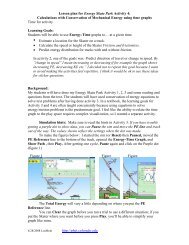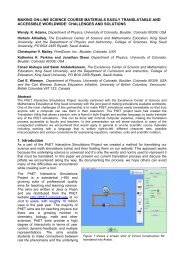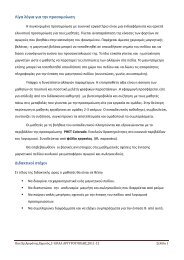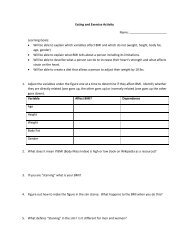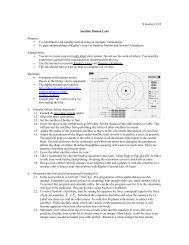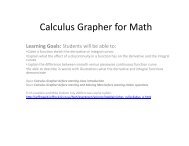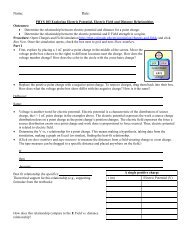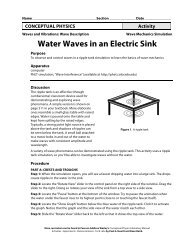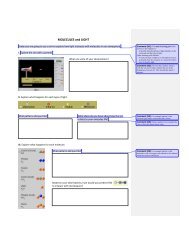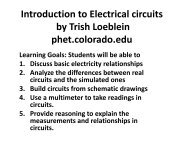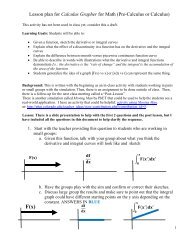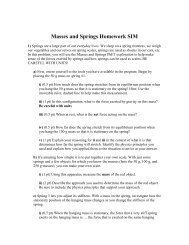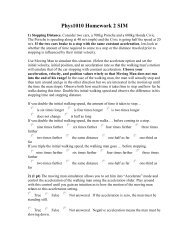You also want an ePaper? Increase the reach of your titles
YUMPU automatically turns print PDFs into web optimized ePapers that Google loves.
Clicker Questions for Wave unit<br />
I gave these clicker questions after<br />
the activity was completed except for<br />
the Wave interference demonstration<br />
day.
Waves on a String
1. If you advance the movie one frame, the knot at point A would be<br />
A. in the same place<br />
B. higher<br />
C. lower<br />
D. to the right<br />
E. to the left<br />
A
A<br />
2. If the person generates a new pulse like the<br />
first but more quickly, the pulse would be<br />
A. same size<br />
B. wider<br />
C. narrower
3. If the person generates another pulse like the first<br />
but he moves his hand further, the pulse would<br />
be<br />
A. same size<br />
B. taller<br />
C. shorter<br />
A
A<br />
4. If the person generates another pulse like the first<br />
but the rope is tightened, the pulse will move<br />
A. at the same rate<br />
B. faster<br />
C. slower
A<br />
Intro slide for following questions
A<br />
5. If you advance the movie one frame, the<br />
knot at point A would be<br />
A. in the same place<br />
B. higher<br />
C. lower<br />
D. to the right<br />
E. to the left
A<br />
6. If you advance the movie one frame, the<br />
pattern of the waves will be<br />
_________relative to the hand.<br />
A. in the same place<br />
B. shifted right<br />
C. shifted left<br />
D. shifted up<br />
E. shifted down
A<br />
7. If the person starts over and moves his hand<br />
more quickly, the peaks of the waves will<br />
be<br />
A. the same distance apart<br />
B. further apart<br />
C. closer together
8.If you lower the frequency of<br />
a wave on a string you will<br />
A. lower its speed.<br />
B. increase its wavelength.<br />
C.lower its amplitude.<br />
D.shorten its period.<br />
Wave properties
Fourier clicker questions
1. What will this wave look like<br />
after it reflects?<br />
A.<br />
Fixed end<br />
B.<br />
c.<br />
D.
2. What will this wave look like<br />
after it reflects?<br />
A.<br />
Loose end<br />
B.<br />
c.<br />
D.
3. The pulse on the left is moving right, the pulse<br />
on the right is moving left. What do you see<br />
when the pulses overlap?<br />
11 Wave addition simple pulse
A<br />
B<br />
C<br />
D<br />
E<br />
Rest of question
answer<br />
B
After interacting
4. If these two waves were moving<br />
through water at the same time, what<br />
would the water look like?<br />
Wave 1<br />
Wave 2<br />
x<br />
x<br />
A<br />
B<br />
C<br />
D
CT-1. At a particular instant of time, wave<br />
1 and wave 2 are as shown. What does<br />
the sum of the two waves look like? f total<br />
= f1 + f2<br />
A)<br />
f1(x)<br />
f2(x)<br />
x<br />
x<br />
B)<br />
C)<br />
D)<br />
Original question from CU course
Wave Interference
1. What will this wave look like<br />
after it reflects?<br />
A.<br />
Fixed end<br />
B.<br />
c.<br />
D.
2. What will this wave look like<br />
after it reflects?<br />
A.<br />
Loose end<br />
B.<br />
c.<br />
D.
Draw what you think this wave will<br />
look like after reflecting off the barrier.
3. Which one is the reflection pattern?<br />
Wave pulse from speaker A B
“Sound waves are three<br />
dimensional.”<br />
Talk to your partner:<br />
• What evidence you have that<br />
supports this.<br />
• How the wave could be<br />
represented<br />
• How would reflection change?
Sketch what you think the pattern<br />
will look like
Measurements
Paused clips
Sound activity<br />
I used questions 1-8 with the sound activity<br />
and the rest on the next day.
1. A student started the speaker by<br />
clicking on the stopwatch. How many<br />
sound waves are there is this trial?<br />
A. 3<br />
B. 5<br />
C. 4<br />
D. 8
2. What is the speed of the sound<br />
waves shown here?<br />
A. 300 m/s<br />
B. 330 m/s<br />
C. 0.0030 m/s<br />
D. 66 m/s
3. What is the frequency of the<br />
sound waves shown here?<br />
A. 0.0037 hz<br />
B. 66 hz<br />
C. 260 hz<br />
D. 300 hz<br />
E. 330 hz
4. What is the period of the sound<br />
waves shown here?<br />
A. 0.0151 s<br />
B. 0.0037 s<br />
C. 260 s<br />
D. 300 s<br />
E. 330 s
5. What is the wavelength of the<br />
sound waves shown here?<br />
A. 5 m<br />
B. 1.3 m<br />
C. 1 m<br />
D. 0.71 m<br />
E. 300 m
6. If your lab partner moved the<br />
frequency slider to the left so that<br />
it changed from 500 to 250<br />
the period would be<br />
A. twice as big<br />
B. 1/2 as big<br />
C. Stays the same<br />
D. 1/4 times as big<br />
E. Not enough information to decide
7. If you moved the slider to the<br />
far right, doubling the amplitude,<br />
the period would be…<br />
A. twice as big<br />
B. 1/2 as big<br />
C. Stays the same<br />
D. 1/4 times as big<br />
E. Not enough information to decide
Sound waves traveling out<br />
8. If the speaker vibrates back and forth at<br />
200 Hz how much time passes between each time it<br />
produces a maximum in pressure?<br />
a. 0.2 seconds<br />
b. 0.200 seconds<br />
c. 0.005 seconds<br />
d. 0.02 seconds<br />
e. 0.05 seconds
9.A speaker is playing a constant note.<br />
What happens to the sound when you<br />
1) put a solid, thick glass jar over it and<br />
2) pump the air out from the jar.<br />
A) 1 => hardly any difference<br />
2 => hardly any difference<br />
B) 1=> hardly any difference<br />
2 => much quieter<br />
C) 1=> noticeably quieter<br />
2 => hardly any MORE quiet<br />
D) 1=> noticeably quieter<br />
2=> much quieter still (near silence)<br />
E) None of these/something else/??
10. If you could put a dust<br />
particle in front of the speaker.<br />
Which choice below shows the<br />
motion of the dust particle?<br />
A) (up and down)<br />
B) (steadily to the right)<br />
dust<br />
C) (left and right)<br />
D) (no motion)<br />
E) (circular path)
11.The picture shows “displacement as a function<br />
of location along a string”<br />
What is the wavelength (“λ”)?<br />
C<br />
B<br />
D<br />
E none of these<br />
A<br />
Remember X axis is position<br />
not time<br />
Fundamentals of waves
12.The picture shows “displacement as a function<br />
of location along a string”<br />
What is the amplitude?<br />
C<br />
B<br />
D<br />
E none of these<br />
A<br />
Remember X axis is position<br />
not time<br />
Fundamentals of waves
13.Looking at the following waveform, what<br />
is the period? assume it repeats itself over and over<br />
1 2<br />
time (sec)<br />
A.1 sec<br />
B. 2 sec<br />
C. 1 m/s<br />
D. 2 m/s<br />
E.Not enough information
14 Looking at that same wave,<br />
what is its speed?<br />
1 2<br />
Time (sec)<br />
A.1/2 m/s<br />
B.2 m/s<br />
C.5 m/s<br />
D.20 m/s<br />
E.Not enough information
CT 2.1.10<br />
15 The wavelength, λ, is 10 m. What is the speed of<br />
this wave?<br />
1<br />
Time (sec)<br />
A) 1 m/s<br />
B) just under 7 m/s<br />
C) 10 m/s<br />
D) 15 m/s<br />
E) None of the above/not enough info/not sure
CT 2.2.3<br />
16 What is the period of this wave?<br />
Amp<br />
t=0 t 1<br />
t 2<br />
time<br />
a) t 1<br />
b) t 2<br />
c) Not at all defined<br />
d) Not well defined, but t 1 is the best answer<br />
e) Not well defined, but t 2 is the best answer
17 What is the period of this wave?<br />
Amp<br />
0<br />
t 1 t 2 t 3<br />
time<br />
a) t 1<br />
b) t 2<br />
c) t 2 -t 1<br />
d) t 3 -t 1<br />
e) None of the above<br />
t 4
18 Which one of the following is most likely to<br />
be impossible?<br />
A. Transverse waves in a gas<br />
B. Longitudinal waves in a gas<br />
C. Transverse waves in a solid<br />
D. Longitudinal waves in a solid<br />
E. They all seem perfectly possible
Reflection and Lenses<br />
Plane mirrors only
Where will the image appear?<br />
A. On the left, at<br />
the zero mark.<br />
B. On the right, at<br />
the 150 mark.<br />
C. On the right, at<br />
the 200 mark.<br />
D. On the right, at<br />
the 300 mark.
How will the image look?<br />
A. Same size<br />
B. Smaller<br />
C. Larger<br />
D. Same size<br />
E. Smaller
Simulation results
Where will the image appear if<br />
the lens were concave?<br />
A. On the left, at<br />
the zero mark.<br />
B. On the left, at<br />
the 67 mark.<br />
C. On the left, at<br />
the 33 mark.<br />
D. On the right, at<br />
the 200 mark.
How will the image look?<br />
A. Same size<br />
B. Smaller<br />
C. Larger<br />
D. Same size<br />
E. Smaller
If the lens is made fatter in the<br />
middle, how will the image change?<br />
A. Larger, further<br />
away<br />
B. Smaller, further<br />
away<br />
C. Larger, closer<br />
D. Smaller, closer
Answer: closer and smaller
If you replace the lens with a<br />
mirror, the image will be<br />
A. Same size<br />
B. Smaller<br />
C. Larger<br />
D. Same size<br />
E. Smaller
If you move the arrow towards<br />
the mirror, the image will be<br />
A. Same size<br />
B. Smaller<br />
C. Larger<br />
D. Same size<br />
E. Smaller
If the lens had a lower index of<br />
refraction, the image be<br />
A. Same size<br />
B. Smaller<br />
C. Larger<br />
D. Same size<br />
E. Smaller
answer
Resonance<br />
Clicker questions<br />
by Trish Loeblein and Mike Dubson<br />
Learning Goals: Students will be able to:<br />
1. Describe what resonance means for a simple<br />
system of a mass on a spring.<br />
2. Identify, through experimentation, cause and<br />
effect relationships that affect natural<br />
resonance of these systems.<br />
3. Give examples of real-world systems to which<br />
the understanding of resonance should be<br />
applied and explain why. (not addressed in CQs)
1. Which system will have the<br />
lower resonant frequency?<br />
Mass<br />
(kg)<br />
Spring<br />
constant<br />
(N/m)<br />
2.5 5.0<br />
100 100<br />
A) 1 B) 2 C) Same frequency
2. Which system will have the<br />
lower resonany frequency?<br />
Mass<br />
(kg)<br />
Spring<br />
constant<br />
(N/m)<br />
5.0 5.0<br />
200 100<br />
A) 1 B) 2 C) Same frequency.
3. Which system will have the<br />
lower resonance frequency?<br />
Mass (kg) 3.0 3.0<br />
Spring<br />
constant<br />
(N/m)<br />
Driver<br />
Amplitude<br />
(cm)<br />
400 400<br />
0.5 1.5<br />
A) 1 B) 2 C) Same frequency.
4. Which best describes how<br />
the motion of the masses vary?<br />
A. Less driver amplitude results<br />
in greater max height & faster<br />
oscillation<br />
B. More driver amplitude results<br />
in greater max height & faster<br />
oscillation<br />
C. Less driver amplitude results<br />
in greater max height<br />
D.More driver amplitude results<br />
in greater max height<br />
Mass (kg) 3.0 3.0<br />
Spring<br />
constant<br />
(N/m)<br />
Driver<br />
Amplitude<br />
(cm)<br />
400 400<br />
0.5 1.5
4. If the frequency f of the driver is not the<br />
same as the resonant frequency, which<br />
statement is most accurate?<br />
The steady-state amplitude is ..<br />
a) smallest at the highest driver f.<br />
b) largest at the highest driver f.<br />
c) is largest at driver f nearest the resonant<br />
frequency.<br />
d) is independent of driver f.



